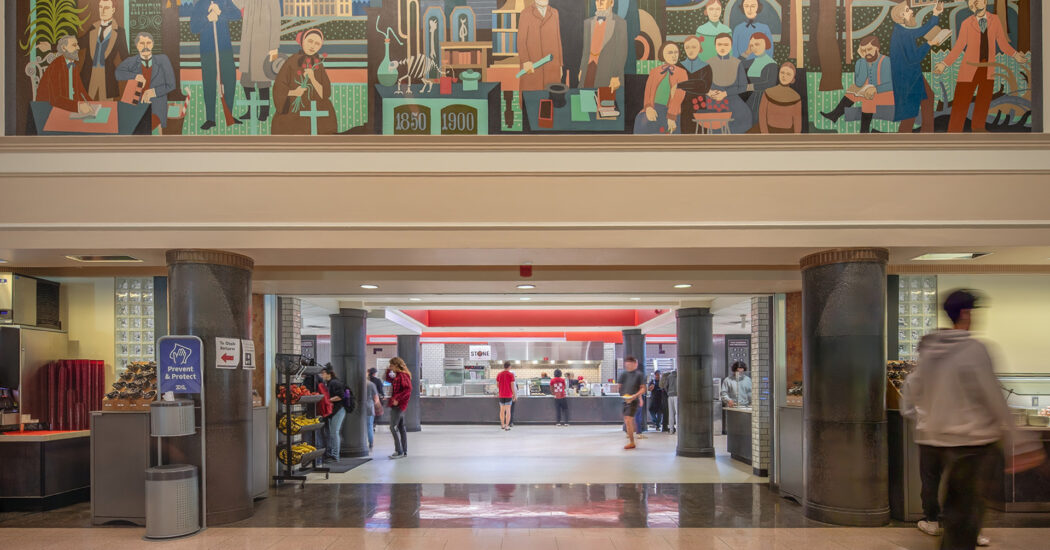Graduating Green
-
Category
Studio-Higher Ed, Innovation -
Posted By
Sarah Hempstead -
Posted On
Sep 20, 2016
40 years ago, our principal preoccupation with energy consumption issues was whether we had integrated enough of the right technology to keep the campus warm in winter and cool in summer. Those solely selfish considerations of personal comfort have given way to a completely different approach; one where the planet is also seen as a key stakeholder in everything we design for the college environment. So how does each individual institution stand out in the powerful “greenwash” as being measurably innovative and effective?
There can be no doubt that today, on campus and across the United States, the sustainable nature of the built environment is a major consideration for undergraduate and graduate students; not least when they come to choose a school. This is not anecdotal. Around a decade ago in fact, a “looser” interest in green matters began to firm up into a real focus. By 2008, Princeton University’s College Hopes and Worries Survey reported that 63% of its (over 10,000) respondents said information on a particular college’s commitment to the environment might impact their decision to apply to or attend that institution.
Higher education has certainly responded. Individual college and campus greening initiatives are taking place in the context of a sector-wide focus on placing sustainability at the very heart of campus life. This emphasis is as well funded, as it is well meaning.
Take the example of the Sustainable Endowments Institute (SEI), founded in 2005 as a special project of Rockefeller Philanthropy Advisers, Inc. The SEI has pioneered research, education, and outreach to advance resilient institutional responses to the climate crisis. It now runs the Billion Dollar Green Challenge.
This impressive initiative encourages colleges, universities, and other nonprofit institutions to invest a combined total of one billion dollars in self‐managed green revolving funds that finance energy efficiency improvements. The SEI also coordinates the College Sustainability Report Card, the first comparative and independent evaluation of campus and endowment sustainability best practices at colleges and universities in the United States and Canada.
If sustainability is very much on the college strategic development horizon, it has also put down roots deep into the fabric of daily college life. Sustainability-themed dorms, eco-initiatives and diverse policies that range from local food sourcing for cafeterias to the recycling of tons of otherwise wasted soap from bathrooms are all manifestations of real working practice, as well as a philosophy. Nor is this simply about saving resources and money – crucial as these complementary benefits are. Green design, and in particular daylight availability, has even been shown to measurably and positively impact student performance.
In this “bright green” context, what contribution can the architect make to a more sustainable campus? The Association for the Advancement of Sustainability in Higher Education states that: “Buildings are generally the largest user of energy and the largest source of greenhouse gas emissions on campuses. Buildings also use significant amounts of potable water. Institutions can design, build, and maintain buildings in ways that provide a safe and healthy indoor environment for inhabitants while simultaneously mitigating the building’s impact on the outdoor environment.”
That’s a pretty strong manifesto for any architect involved in higher education. At Schmidt Associates, we are very proud of the fact that sustainability considerations lie at the heart of all our designs. In fact, they are as important to us as our aesthetic approach. But we have most certainly not arrived by accident at the ability to design buildings that deliver measurable sustainability, as well as being a driver of campus pride. Sustainability is about good technology – and great technologists – as well as good intentions.
To be certain of translating their own good intentions into a demonstrably more sustainable campus, college leadership needs to ask some searching questions before engaging with any architect. These questions will include the following:
- Does the architectural practice concerned have a track record of energy efficient design?
- Does the practice retain its own engineers and technologists as an expert green resource?
- Is the ethos one of genuinely integrated teamwork, so that aesthetics and technology work together from the start to achieve a “truly green” design?
- Can they show precisely how they will arrive at the numbers they put around promised resources savings and performance improvements?
The responses to all these questions will help institution leadership decide whether they are in the kind of committed and proven hands that can create and deliver a real contribution to campus sustainability, as well as a beautiful end result. With so much riding on “graduating green” today, the choice of the right architect has never been more important.







